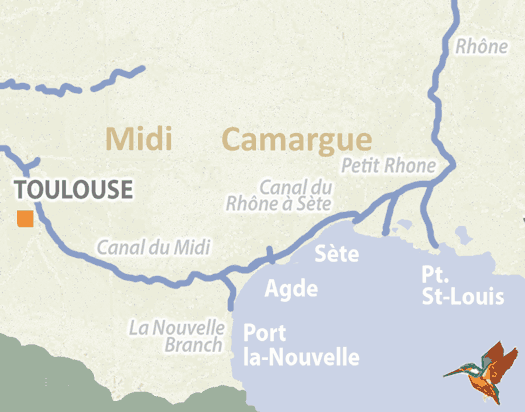Rivers and Canals of Midi and Camargue
Running for 350km between the Rhone river and Toulouse, the celebrated Canal du Midi more than earns its UNESCO World Heritage status and is among the most popular waterways in France. Beginning in Fourques where it leaves the Rhone, the route encompasses the Petit Rhone (20km), the Canal du Rhone a Sete (69km), the Etang de Thau (17km) and the Canal du Midi itself which winds along for 240 irresistible kilometres of unbeatable cruising.
The canal passes through stunning landscapes, beginning with the tall cypress trees and the endless vineyards associated with the Mediterranean, then gradually changing into something more agricultural and less rugged after Carcassonne. As the countryside alters, so does the food and wine – with the impressive vintages the Minervois and the Corbieres close by and the celebrated local dish Cassoulet to try, your voyage is likely to be one of gastronomic as much as geographic discovery, and each faded medieval village which you pass through will cast its own spell.
The Canal du Midi is the victim of its own success, because in high season the volume of hire boat traffic is extremely high and you might find that you have to wait in order to pass through certain locks, and some of the boat handling can be…sub-optimal. Because of this, we recommend that you allow at least three weeks to do the entire length – this will also give you time to explore some of the fluvial byways, for example the branches down to Montpellier and Narbonne.
▶ Detailed canal and river information – Southern France
Petit Rhône
A few kilometres upstream from Arles, the Petit Rhone branches off from the main river at Fourques. Originally one of many narrow channels in the Rhone delta, when construction of the hydro-electric power station at Vallabrueges lowered water levels on the Rhone downstream making the lock at Beaucaire impassable, the Petit Rhone took on a new lease of life as it now formed a critical part of the onward passage to Sete.
Because of this, in 1970 extensive dredging work began to ensure that the tributary had sufficient depth for high capacity barges and the Petit Rhone now offers attractive cruising for 20km to a short cut (and a surprisingly large lock) that takes you on to the Canal du Rhone a Sete. Keep your eyes open – the flora and fauna are both striking and impressive.
▶ Detailed canal and river information – Petit Rhône
Canal du Rhone à Sête and Etang de Thau
The Canal du Rhone a Sete was intended by the heirs of Pierre Paul Riquet, who built the Canal du Midi, to link his engineering masterpiece to the river Rhone and it was they who built the spectacular round lock at Agde. To increase capacity a larger one, more conventional in shape, was built at Beaucaire around 1900 and for many years the canal ran for 98 km from this as far as Sete, but in the 1970s canalisation of the Rhone meant that the lock on to the river at Beaucaire was permanently closed, creating a dead end at the canal terminus. (The attractive basin here remains a destination in its own right and is worth the detour). Today boaters from the Petit Rhone are able access the more usable stretch of the Rhone a Sete at Saint-Gilles by means of a short cut with a large lock, and the navigation continues for 69 km to the entry onto the etang.
The canal affords breath taking glimpses of the Camargue marshland between its high banks and it crosses the River Vidourle and the River Lez – at times of flood risk the junctions to these two waterways may be closed as a precautionary measure. Improvements have been made (such as the bypasses around Aigues Mortes and Frontignan) so that Rhone barges can reach Sete. The main access to the Mediterranean for cruisers in this area is at the sublimely photogenic old citadel of Aigues Mortes, where the short Canal Maritime leads to the holiday resort of Grau de Roi.
Crossing over the Etang de Thau is on the bucket list of many boat owners. Access points at each end are at Sete and the entry onto the Canal du Midi, which is marked by the Les Onglous light house, and the 18km passage between these two points is ravishing. Beyond the narrow spit of land on one hand lies the Mediterranean and on the other hand are the fabled oyster beds of Bouziques. Fine seafood lunches are to be had in this port and the other two which grace the etang – Meze and Marseillan, although the moorings in all of them can be expensive.
▶ Detailed canal and river information – Canal du Rhone à Sête
Canal du Midi
The Canal du Midi runs from the Etang de Thau to Toulouse, wending its way through some of the finest wine districts in the south, through the vineyards of the Minervois and Corbieres, and the 240km journey is one of the most famous and enjoyable cruises on the whole of the French network.
An engineering project way ahead of its time, the canal was designed and built by Pierre Paul Riquet, a former tax collector with an eye for investments: he perceived there was a need for a trading link between the Mediterranean and the Atlantic that would obviate the need for shipping to travel through the Straits of Gibraltar, a challenging passage as France was frequently at war with Spain during this period. Riquet pitched his proposal to Colbert who was Louis X1V’s minister of finance, the concession to build the canal was granted and work began in 1662. It is said that when the King saw the early accounts, he was so horrified by the level of expenditure that he cancelled the project, but Riquet kept going, drawing on his own money, and was eventually able to demonstrate the true value of the waterway, so that official funding was restored and the canal opened in 1681.
As you cruise along you will admire – and use – some of the many engineering masterpieces which gave Riquet the reputation he still enjoys to this day. There is the round lock at Agde, the Orb aqueduct and the Fonserannes locks in Beziers, the first canal tunnel ever built at a Malpas and the elaborate feeder system which keeps the whole thing going, centred on the Saint-Ferreol reservoir. Regular droughts and the increasing need for agricultural irrigation has led to difficulties with water levels, but the new reservoir at Montbel which feeds into the existing one at Ganguise has helped to rectify the problems.
Boats can access the Mediterranean at two points along the canal: via the round lock at Agde, which leads onto the Herault river and out to sea, or via La Nouvelle Embranchement (also known as the Canal de la Robine), which leaves the Midi and passes through Salleles and Narbonne on a 37km passage down to the commercial Port la Nouvelle and the sea beyond.
▶ Detailed canal and river information – Canal du Midi
La Nouvelle Embranchement (Canal du Midi)
La Nouvelle Embranchement runs from Cesse on the Canal du Midi to the Mediterranean and is made up of three distinct sections: the 5km Canal de Jonction, a short connecting stretch of the River Aude, then the 32km Canal de La Robine.
There were Roman attempts to canalise the River Aude and create a route to the sea, but the river changed its course and the plan failed. Later a feeder canal was built to bring drinking water to Narbonne (the name La Robine derives from the French for tap, robinet) and after the Canal du Midi opened in 1681 this was enlarged for navigational purposes. The missing piece of the jigsaw came in 1787 when the Canal de Jonction on was opened. During the 1980s the waterway was upgraded to accommodate 250 tonne barges in an attempt to sustain the commercial transport of wine from the region onwards, but the lure of road freight was irresistible and nowadays the canal is used purely for leisure purposes, although it does provide a vital connection between the waterways network and the sea.
▶ Detailed canal and river information – La Nouvelle Embranchement
French waterway regions – North | North-East | North-Central | West | Centre | South-East | South | South-West
British-Irish waterway regions – Northern | East Midlands | West Midlands | Welsh | Southern | Scottish | Irish

